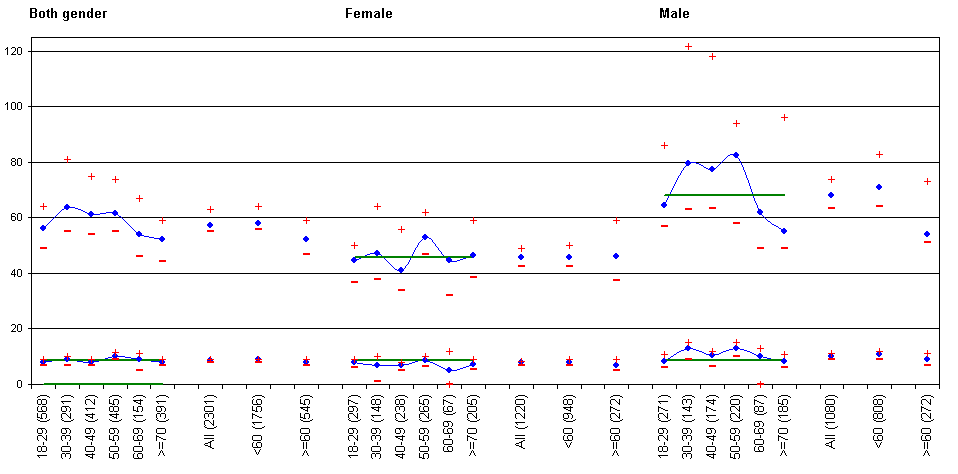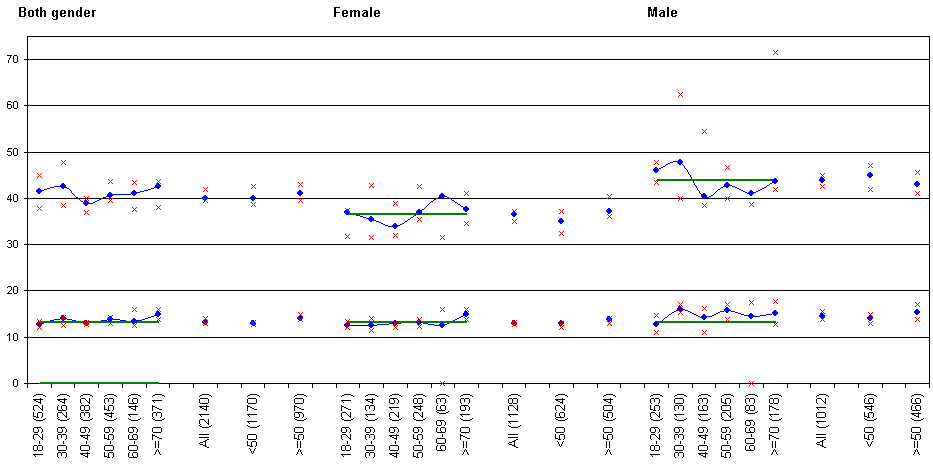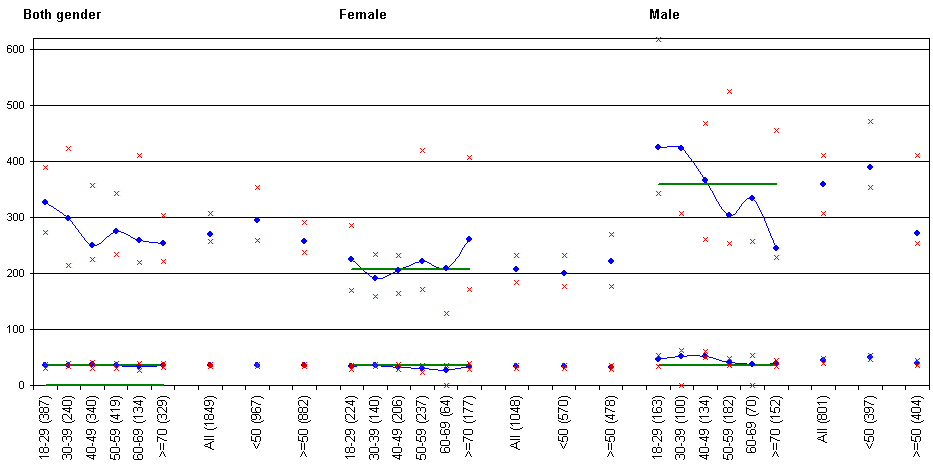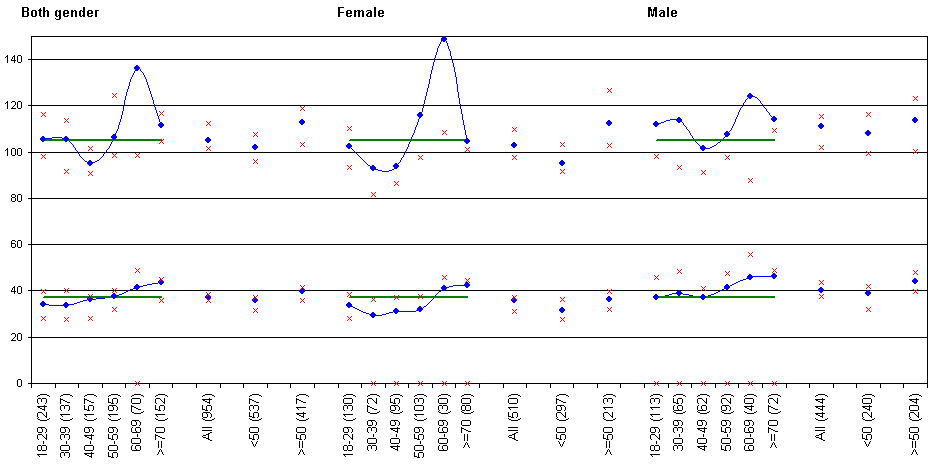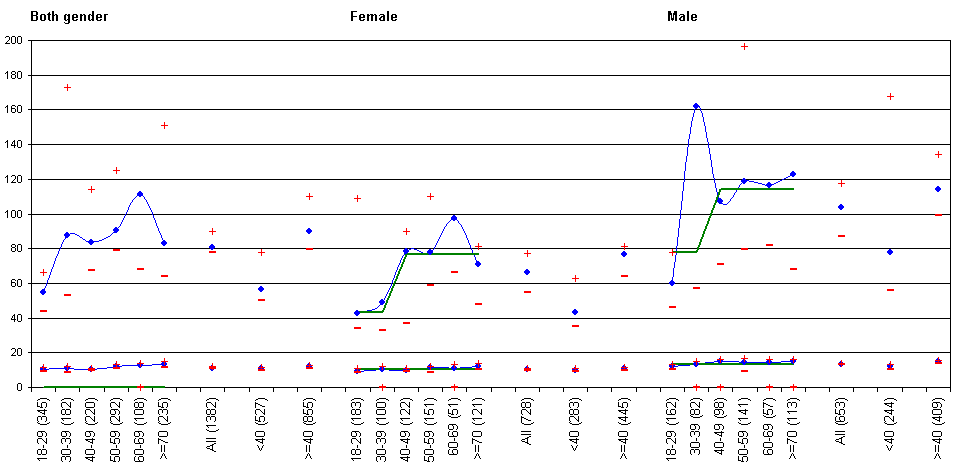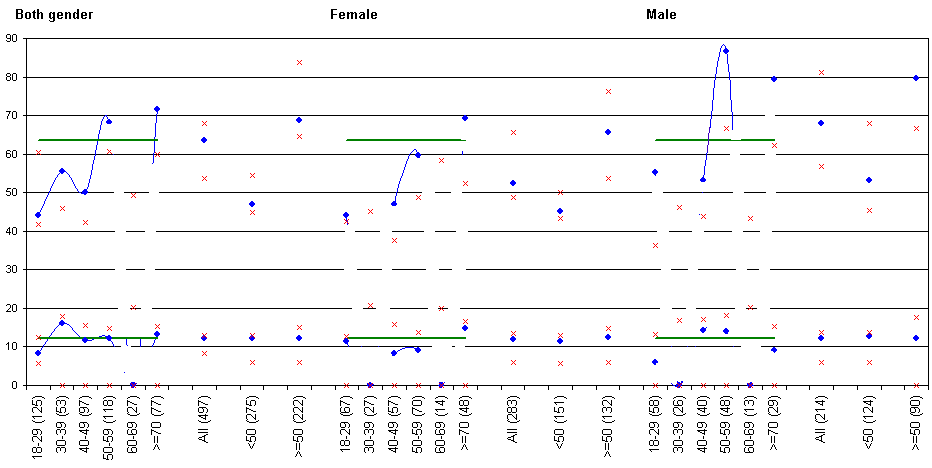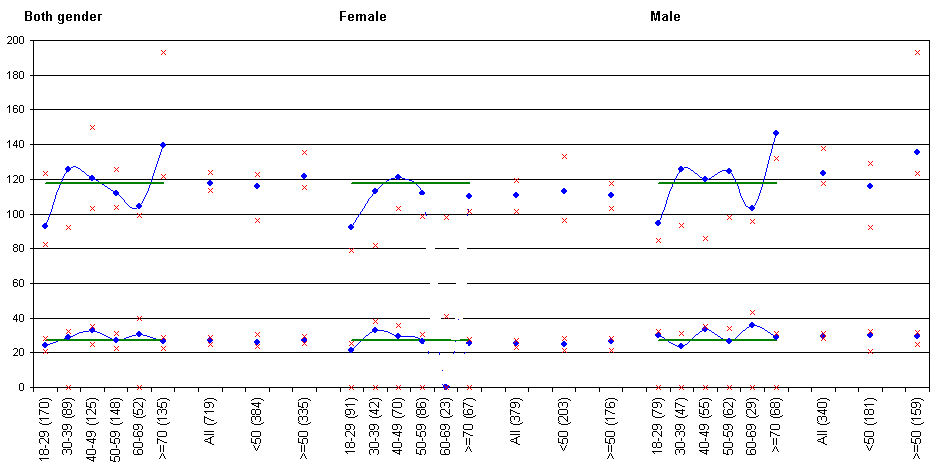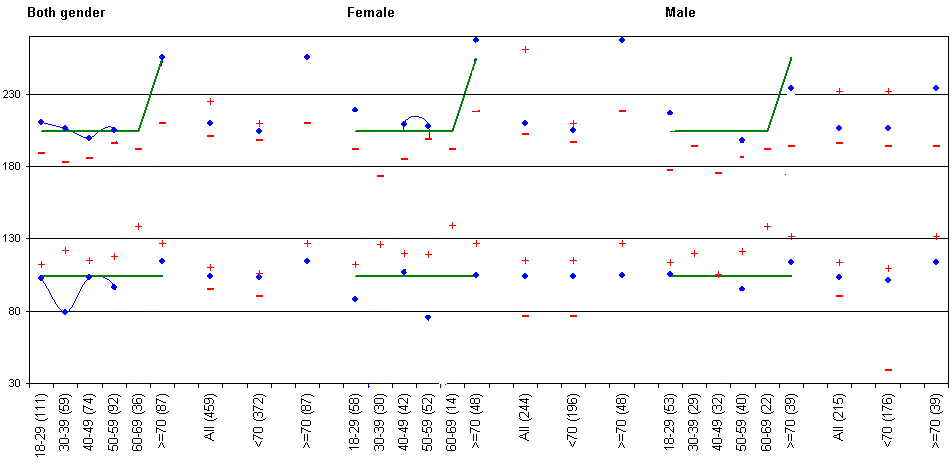Suggested reference intervals for 8 serum enzymes based on data from the NORIP database
Report from the working group on enzymes established by the Norwegian Association of Clinical Chemistry:
Members of working group (in alphabetical order): Knut Lande, Pål Rustad, Heidi Steensland, Johan Strømme (leader), Liv Theodorsen, Petter Urdal.
In December 2002 the Norwegian Association of Clinical Chemistry established a number of working groups with the objective to evaluate the preliminary reference intervals for 25 commonly analysed serum components presented by the Nordic Reference Interval Project, NORIP (1).
Here we present the proposal from the working group on 8 serum enzymes, alanine aminotranseferase (ALT), aspartate aminotransferase (AST), creatinekinase (CK), lactatedehydrogenase (LD), alkaline phophatase (ALP), gamma-glutamyltrasferase (GT),amylase (AMY), and pancreatic amylase (P-AMY).
Materials and methods
Detailed information about the selection of reference persons, collection and handling of samples, as well as the methods used for analysis of the thawed sera is available on the Internet (1). Here one will also find information about the general criteria used for excluding reference persons and results.
For enzymes the NORIP project used strict criteria concerning methodology for inclusion of the reported results from the laboratories: Only results obtained by methods compatible with and traceable to the IFCC reference methods at 37 oC were included, and only results from complete analysis systems (reagents, calibrator and instrumentation supplied by one and the same manufacturer). In cases where local adjustment slopes and intercepts had been used, the reported values were recalculated to original values. Finally the laboratory mean for each enzyme was compared to the overall mean of the respective enzyme. When large deviations were seen in the mean, the whole set was excluded. In the case of AMY and P-AMY only results from the IFCC compatible EPS method of Roche/Boehringer were selected. Because of heterogeneity of the ALP and LD methods used during 1999 –2001, none of the wet chemistry results were included. Instead reanalysis of LD and ALP was done. 464 randomly picked samples originating from the five countries were reanalysed in 3 laboratories using IFCC compatible methods on Roche Modular systems.
Ortho Clinical Diagnostics claims compatibility to the IFCC reference methods at 37° for the Vitros analysis systems (250-950 models) in case of AST, ALT, CK, GT and ALP. Reference intervals on these enzymes were initially processed separately. However, it was found that these reference intervals compared well to the reference intervals obtained by the wet chemistry methods, particularly at the important upper limits. The working group therefore decided to include both results from the wet and dry chemistry methods in the final calculations of the reference intervals for 5 of the 8 enzymes. Since the Vitros system does not apply IFCC compatible methods for LD and AMY these results were not included.
Whereas the number of results excluded by the general criteria applied for other components only amounted to a few percentages (1), the number excluded due to incompatibility of the enzyme methods to the IFCC reference methods varied from 14 to 56 % for the enzymes assayed with wet chemistry, and from 5 to 12% for the enzymes assayed with IFCC compatible dry chemistry (Vitros 250-950) (Table 1).
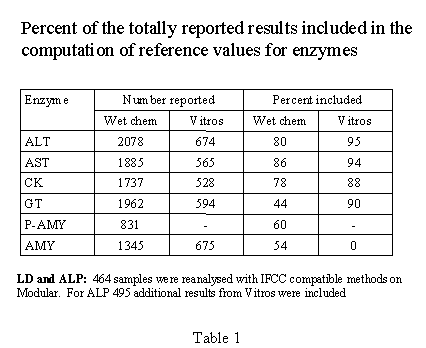
Table 2 shows the number of laboratories from each country that satisfied the compatibility criteria for the various enzymes.
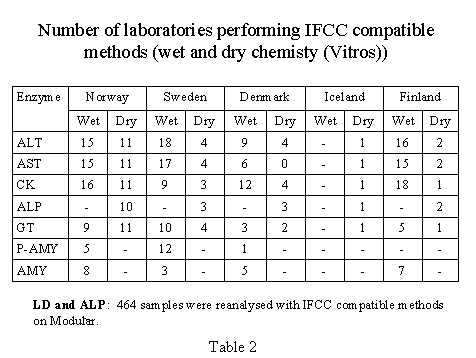
Calculation of reference limits
2.5 and 97.5 percentile reference limits are calculated using Refval 4.0 according to IFCC recommendations by simple non-parametric method. Partitioning by gender and age have been evaluated by a modification of Refval 4.0 according to principles outlined by Lahti et al (2) with the possible outcome according to percent of subpopulation outside common reference limit:
Non-partitioning: Between 1.8% and 1.2%
Moderate: Between 0.9% and 1.8% or between 3.2% and 4.1%
Partitioning: Less than 0.9% or above 4.1%
Outlier test
As the Dixon test used in Refval 4.0 failed to detect 2 obviously extreme but close CK values (1065 and 1068 U/L) this test was replaced by a new outlier test: All data outside m+4s (logarithmic transformed) were discarded as outliers. The limits of exclusion and number of results excluded are shown in Table 3.
| Gender | Limit of exclusion |
No excluded |
|
| ALT | Female | 104 |
2 |
| Male | 162 |
1 |
|
| AST | Female | 58 |
1 |
| Male | 77 |
2 |
|
| CK | Female | 515 |
2 |
| Male | 885 |
2 |
|
| GT | Female | 124 |
3 |
| Male | 217 |
0 |
|
| ALP | Female/male | 188 |
1 |
| LD | Female/male | 289 |
0 |
| AMY | Female/male | 247 |
1 |
| P-AMY | Female/male | 132 |
0 |
Table 3: Upper limit of exclusion according to mean + 4s (logaritmic transformed data)
Alanine aminotransferase (ALT)
Preliminary reference intervals suggested by NORIP (1)
Women: 7 - 45
Men: 10 - 72
Distribution of results
The distribution of ALT activity concentrations was slightly skewed towards higher levels (1). The average concentration was higher in men than women, particularly at the higher percentiles (Table 4, Fig. 1). We therefore suggest using separate reference limits for women and men. The activity levels were slightly higher in men below than above the age of 60 years (Table 4), but the partitioning test was "moderate" (1). No such age difference was found in women.
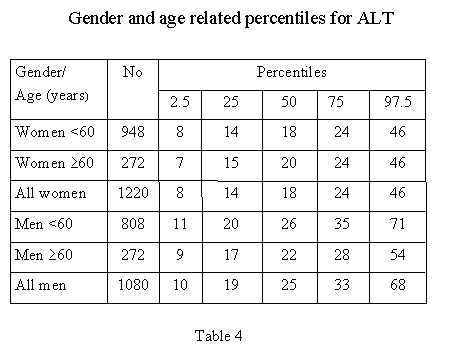
Fig. 1: Gender and age related reference limits for ALT. Blue lines: High and low reference limits. Red crosses: 90% confidence intervals (CI) for reference limits. If the number of reference values are <120, low CI for low limit and high CI for high limit cannot be calculated. Green, straight lines: Suggested reference limits (click on plot to enlarge!)
There was a positive correlation between ALT activity and BMI, giving a higher 97.5 percentile both for women and men with BMI above 28 kg/m2 than below (Table 5). In the diagnostic use of ALT this should be kept in mind. But we do not suggest separate limits related to BMI since the correlation was gradual through the whole range of BMI, and the results were greatly scattered (1).
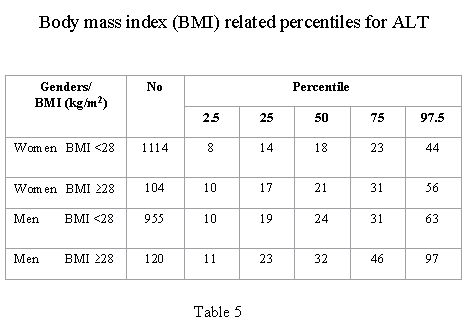
The median values on ALT activity concentrations found in men from 4 of the 5 countries showed much the same 97.5 percentiles, ranging from 61 to 69 U/L. Those from Denmark showed a 97.5 percentile of 87 U/L (1). Excluding the Danish values had minor influence on the 97.5 percentile
| Suggested reference intervals for ALT | |
| Women | 10 – 45 U/L |
| Men: | 10 – 70 U/L |
For all the enzymes, the non-rounded figures together with 90 % confidence intervals for the upper limits are given in table 6.
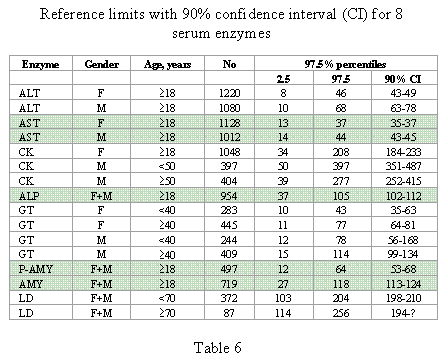
Aspartate aminotransferase (AST)
Preliminary reference intervals suggested by NORIP (1)
Women: 13 - 35
Men: 14 - 44
Distribution of results
The distribution of AST activity concentrations was slightly skewed towards higher levels (1). They were on the average slightly higher in men than women, particularly at the higher percentiles (Table 7, fig. 2). It was not found any relations to age (Table 7) or to BMI (1).
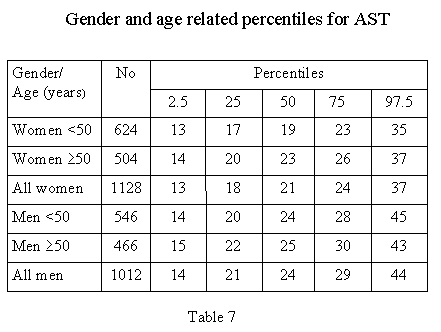
Fig. 2: Gender and age related reference limits for AST. Blue lines: High and low reference limits. Red crosses: 90% confidence intervals (CI) for reference limits. If the number of reference values are <120, low CI for low limit and high CI for high limit cannot be calculated. Green, straight lines: Suggested reference limits (click on plot to enlarge!)
| Suggested reference intervals for AST | |
| Women | 15 - 35 U/L |
| Men: | 15 – 45 U/L |
Creatinekinase (CK)
Reference intervals suggested by NORIP (1)
Women: 35 - 209
Men <50 years: 52 - 371
Men ³ 50 years: 43 - 371
Distribution of results
The distribution of CK activity concentrations was highly skewed towards higher levels (1). They were on the average higher in men than in women at all percentiles (Table 8). We therefore suggest different limits for women and men. In men there was a fall in 97.5 percentile with increasing age at least up till 50 years (Table 8, Fig. 3). Partitioning test was positive at this level for men. The latter makes it appropriate to suggest age related reference limits for men. It should however, be emphasised that the higher levels were particularly found in the age group from18 to 40 years. It was not found any significant relations to age in women (Fig. 3) or to BMI in either men or women (1).
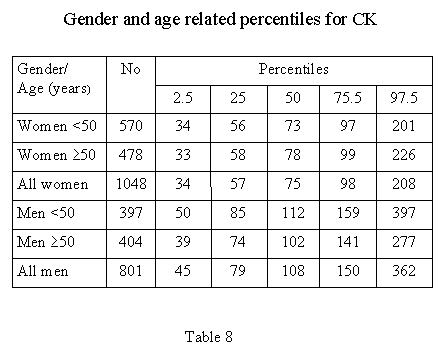
Fig. 3: Gender and age related reference limits for CK. Blue lines: High and low reference limits. Red crosses: 90% confidence intervals (CI) for reference limits. If the number of reference values are <120, low CI for low limit and high CI for high limit cannot be calculated. Green, straight lines: Suggested reference limits (click on plot to enlarge!)
There were comparatively many high activities reported among men from Finland, - 10 of the 15 activities above 400 U/L originated form Finland. Due to this the 97,5 percentile in the Finnish men was 465 U/L, whereas the 97.5 percentile of the other countries ranged from 255 to 349 U/L. Excluding all the Finnish male values from calculation would decrease the 97.5 percentile for men <50 years from 397 U/L to 357 U/L (corrected 8/7-2003 from 326 U/L). The effect of a few high values is particularly large because of the flatness of the distribution curve around the 97.5 percentile level. It should be recalled in this connection that all results on samples from reference persons who had participated in strenuous physical activity the last week (1), were not included in the CK calculations. Moreover, especially scrutinising the questionary of the persons with CK above 280 U/L revealed nothing that could explain the high activities. The one person with highest CK activity, 725 U/L, was a man from Somalia. Africans are known to have on the average higher CK activities than Caucasians, but not in that order of magnitude (3). Removing his value would decrease the 97.5 percentile to 383 U/L.
| Suggested reference intervals for CK | |
| Women | 35 – 210 U/L |
| Men <50 years | 50 – 400 U/L |
| Men ³ 50 years | 40 – 280 U/L |
Alkaline phosphases (ALP)
Preliminary reference intervals suggested by NORIP (1)
Women and men: 33 - 110 U/L
Distribution of results
The ALP activity concentrations showed a near normal distribution, with only a small "tail" of higher values (1). All percentiles of the male values were slightly higher than those of the female values, but not sufficiently pronounced to suggest gender related limits (Table 9). Neither was there any significant difference with respect to age (Table 9, Fig. 4) apart from a comparatively high 97.5 percentile values for both genders at the age of 60-69 years. The uncertainty is great as seen from the large confidence intervals for each age group because the numbers were comparatively low (Fig. 4). There was a slight gradual increase related to BMI, and no differences between countries (1).
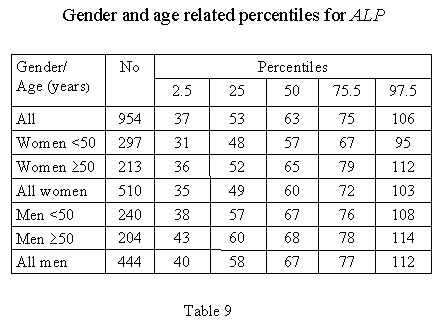
Fig. 4: Gender and age related reference limits for ALP. Blue lines: High and low reference limits. Red crosses: 90% confidence intervals (CI) for reference limits. If the number of reference values are <120, low CI for low limit and high CI for high limit cannot be calculated. Green, straight lines: Suggested reference limits (click on plot to enlarge!)
| Suggested reference intervals for ALP | |
| Women and men | 35 – 105 U/L |
Gamma-glutamyltransferase (GT)
Preliminary reference intervals suggested by NORIP (1)
Women: <40 years: 10 – 37 U/L
Women: ³ 40 years: 10 – 78 U/L
Men <40 years: 13 – 88 U/L
Men ³ 40 years: 13 – 119 U/L
Distribution of results
The distribution of GT activity concentrations was markedly skewed towards higher level (1). The GT activity was higher in men than women, particularly at the higher percentiles (Table 10). The 97.5 percentile showed a steep increase in both genders at the age of about 40 years (Table 10, Fig. 5). We will suggest different limits for both women and men above and below 40 years of age.
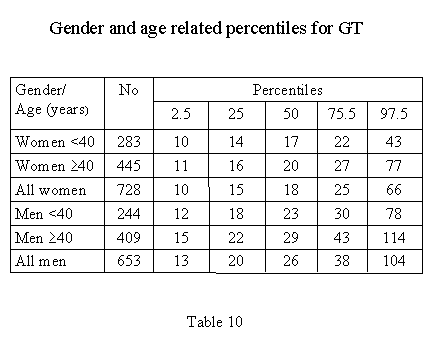
Fig. 5: Gender and age related reference limits for GT. Blue lines: High and low reference limits. Red crosses: 90% confidence intervals (CI) for reference limits. If the number of reference values are <120, low CI for low limit and high CI for high limit cannot be calculated. Green, straight lines: Suggested reference limits (click on plot to enlarge!)
There was a weak positive correlation between GT activity and BMI (1) with an increase in the 97.5 percentiles of about 10 U/L for those above BMI of 28 compared to those below. We do not suggest separate limits related to BMI.
Clear differences between the countries were observed. Systematically high values were found in the Danish population (1). Among Swedish men the 97.5 percentile was high, whereas in the Norwegian men and women the 97.5 percentile was low.
| Suggested reference intervals for GT | |
| Women: <40 years | 10 –45 U/L |
| Women: ³ 40 years | 10 –75 U/L |
| Men <40 years | 10 – 80 U/L (corrected 28/4-03 from 10 - 60 U/L) |
| Men ³ 40 years | 15 – 115 U/L |
Pancreatic amylase (P-AMY)
Reference intervals suggested by NORIP (1)
Women and men: 12 - 64
Distribution of results
The P-AMY activities showed a near normal distribution, with a little "tail" of higher values (1). The 97.5 percentile, but not the other percentiles, was somewhat higher in men than women (Table 11). A similar difference was found with respect to age (Table 11). We do not consider these differences sufficiently pronounced to suggest gender or age related upper limits. It was not found any relations to BMI. When the data were divided in age groups of 10 years, the uncertainty became too large (Fig. 6). The P-AMY was nearly exclusively performed in Sweden and Norway.
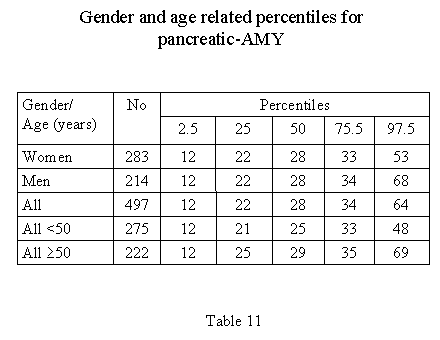
Fig. 6: Gender and age related reference limits for pancreatic-AMY. Blue lines: High and low reference limits. Red crosses: 90% confidence intervals (CI) for reference limits. If the number of reference values are <120, low CI for low limit and high CI for high limit cannot be calculated. Green, straight lines: Suggested reference limits (click on plot to enlarge!)
| Suggested reference intervals for pancreatic-AMY | |
| Women and men | 10 – 65 U/L |
Total amylase (AMY)
Preliminary reference intervals suggested by NORIP (1)
Women and men: 27 - 119 U/L
Distribution of results
The distribution of AMY activities showed a slight skewness to towards higher levels (1). There was no marked age or gender related differences in the percentiles (Table 12, Fig. 7). The 97.5 percentile for AMY as for P-AMY (see above) was higher in data reported from Sweden than from the other countries. It was not found any relations to BMI.
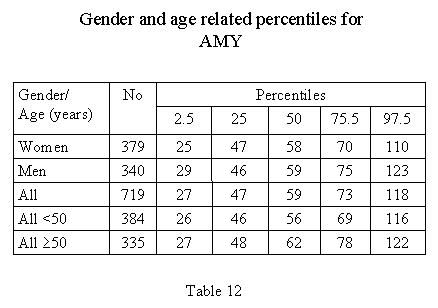
Fig. 7: Gender and age related reference limits for AMY. Blue lines: High and low reference limits. Red crosses: 90% confidence intervals (CI) for reference limits. If the number of reference values are <120, low CI for low limit and high CI for high limit cannot be calculated. Green, straight lines: Suggested reference limits
| Suggested reference intervals for AMY | |
| Women and men | 25 – 120 U/L |
Lactate dehydrogenase (LD)
Preliminary reference intervals suggested by NORIP (1)
Women and men: 104 - 210 U/L.
Distribution of results
The LD activity showed a near normal distribution (1). There was no gender related differences in the 2.5 and 97.5 percentiles (Table 13, Fig. 8). The activities were higher at all percentiles for those older than 70 years, whereas the 97.5 percentiles for those below 70 and below 60 were nearly the same (Table 13). The partition test was positive at both ages (1). We suggest separate limits for those below and above 70 years. It was not found any relations to BMI (1).
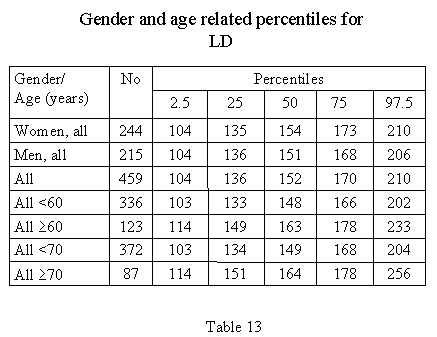
Fig. 8: Gender and age related reference limits for ALP. Blue lines: High and low reference limits. Red crosses: 90% confidence intervals (CI) for reference limits. If the number of reference values are <120, low CI for low limit and high CI for high limit cannot be calculated. Green, straight lines: Suggested reference limits (click on plot to enlarge!)
| Suggested reference intervals for LD | |
General Comments
The reference intervals suggested here are generally broader than those suggested by Schumann and Klauke (4) on behalf of the IFCC expert panel (Table 15), and also broader than those commonly used in the Nordic countries till now. This is particularly marked for CK and GT.
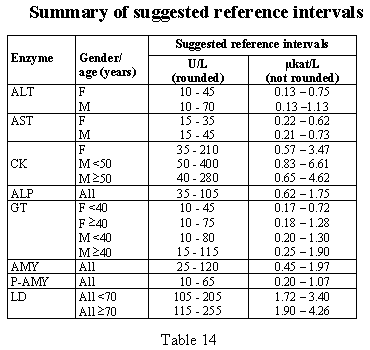
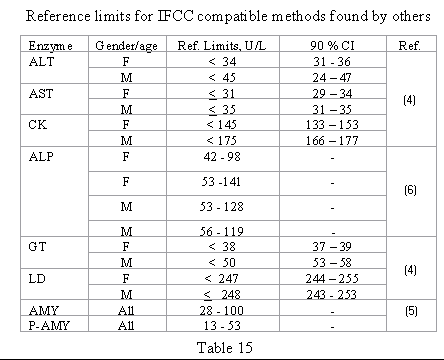
The main reason, we believe, is related to the different ways by which the reference persons have been selected. Our reference persons were scrutinised before recruitment with respect to being healthy, and exclusions were undertaken on the basis of predefined biochemical and clinical criteria (1). They were, on the other hand, recruited from 5 different countries, which may increase the reference intervals. For certain enzymes such as CK and GT, clear differences between countries were indeed observed. For example, excluding CK values for men from Finland decreased the 97.5 percentile from 397 to 326 U/L. But the latter value is still higher than what we are used to as the upper reference limit. The reasons to this difference are unknown.
Schuman and Klauke (4), examining ALT, AST, CK, GT and LD, used another approach in that they selected their reference persons from a patient material. They had been examined by one of three enzyme profiles routinely performed in the hospital. These profiles consisted of from 3 to 7 serum enzymes, one of which was in each case the target enzyme in question. Only provided that all the enzyme values of the profile were below the respective reference limit, presumable a 97.5 percentile limit, serum samples from this patient was included in the study. This means that the enzyme data for each enzyme must have been strongly truncated at the upper part, which again will tend to give low 97,5 percentiles. In accordance with this they found at this level narrower 90 confidence intervals than we did (Table 15). Moreover the discrepancies were largest for enzymes with a long tail at the upper levels, e.g. CK and GT.
Schumann and Klauke essentially used one analytical system whereas we used a broad range of systems. The diversity of systems used by us may probably have increased the reference range somewhat. Still several lines of evidence suggest that this cannot be a major reason for the broad ranges observed. Firstly, the overall external reproducibility of IFCC compatible methods, as recognised from Nordic EQA data, generally shows CVs in the order of 5-10%. Secondly, the agreement between results obtained with the Vitros systems, which use a highly standardised methodology, and the wet chemistry methods included, was very good.
Regarding the amylases the reference limits found here are in good agreement with those found by Junge et al (5).
The upper reference limit presented for ALP by Tietz and Shue (6) are higher than we found. Apart from the fact that their reference population was of limited number, we have no explanation for the discrepancy.
It is our opinion that too narrow reference intervals, obtained under strictly optimised conditions both with respect to analytical quality and the recruitment of reference persons, may in ordinary health practice cause unnecessary trouble for the patients, and may also cause unnecessary use of laboratory recourses. One should in this connection recall that many different laboratories, also laboratories in different Nordic countries, often use the same reference limits. Moreover, samples from patients may frequently be forwarded for analysis by different laboratories. Perhaps, therefore, reference intervals determined in the way it has been done in the present study may be those most suitable to use as diagnostic guidelines. Here it should also be recalled that reference limits are not equivalent with decision limits. The latter may be quite different from the former in a number of specific diagnostic situations.
Reference limits for children
Only adults were included in NORIP. We are therefore unable to present reference intervals for children and adults below 18 years. It is however well known (7-9) that in children 0-10 years the upper reference limit for LD is about 2 times higher than that of adults, and below 18 years the ALP upper reference limit is 3-4 times higher than in adults. The pancreatic amylase is normally not detectable at birth but increases continuously throughout childhood reaching adult levels at 5-6 years of age. There are great individual variations in the enzyme levels at each age level.
Until more definite data are available we suggest the following reference ranges to be used with children:
Age Reference range
| LD | 0 - 10 years | 100 – 400 U/l |
| 11-17 years | 105 – 205 U/l | |
| ALP | 0 – 17 years | 35 – 400 U/l |
| Pancreatic amylase | 0 – 6 years | The activity increases continuously, reaching adult levels from approx 6 years |
| 7 – 17 years | 15 - 65 U/l |
These reference ranges are not applicable to newborns since enzyme activities may vary considerably during the first weeks of life.
References
- Rustad P, Nordic reference interval project. http://www.furst.no/norip/
- Lathi A, Hyltoft Pettersen P, Boyd JC, Fraser CG, Jørgensen, N. Objective criteria for partitioning Gaussian-distributed reference values into subgroups. Clin Chem 2002; 48: 338-52. Black HR, Quallich H, Gareleck CB. Racial differences in serum creatine kinase levels. Am J Med, 1986, Sep; 81(3): 479-87 (abstract)
- Schumann G, Klauke R. New IFCC reference procedures for the determination of catalytic activity concentrations of five enzymes in serum: preliminary upper reference limits obtained in hospital subjects. Clin Chim Acta, 2003; 327: 69-79.
- Junge, W, Wortmann W, Wilke B, Waldenstrøm J, et al. Development and evaluation of assays for the determination of total and pancreatic amylase to the principle recommended by the IFCC. Clin Biochem. 2001; 34: 607-615.
- Tietz Textbook of Clinical Chemistry. 2nd Edition 1994 Saunders Company, Philadelphia, Pennsylvania.
- Oski´s Pediatrics. Principles and practice. 3rd Edition 1999, Lippincott, Philadelphia, Pennsylvania.
- Nelson Textbook of Pediatrics. 16th Edition 2000, Saunders Company, Philadelphia, Pennsylvania.
